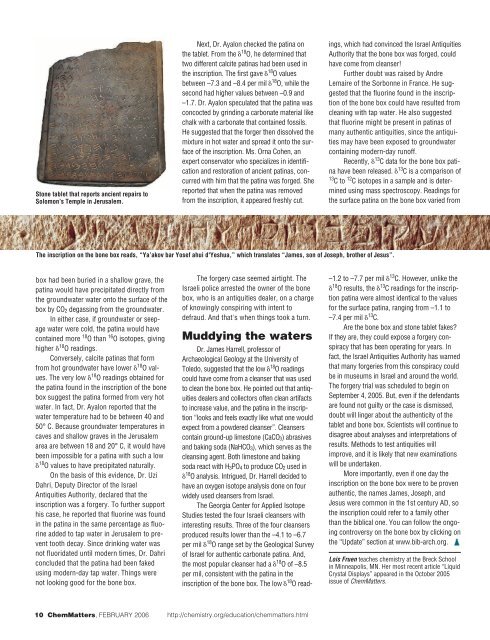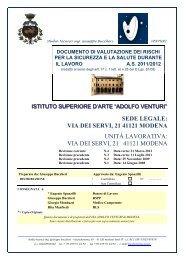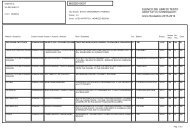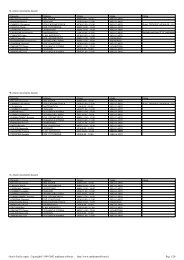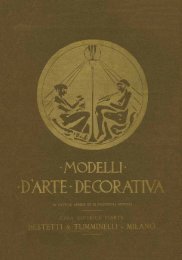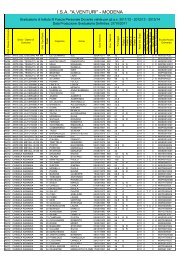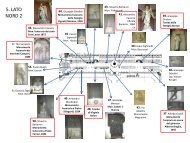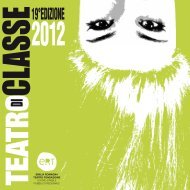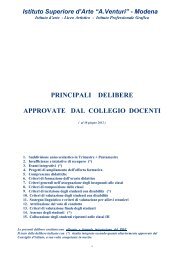and Printing
Super Fibers - A. Venturi
Super Fibers - A. Venturi
- No tags were found...
Create successful ePaper yourself
Turn your PDF publications into a flip-book with our unique Google optimized e-Paper software.
Stone tablet that reports ancient repairs toSolomon’s Temple in Jerusalem.Next, Dr. Ayalon checked the patina onthe tablet. From the 18 O, he determined thattwo different calcite patinas had been used inthe inscription. The first gave 18 O valuesbetween –7.3 <strong>and</strong> –8.4 per mil 18 O, while thesecond had higher values between –0.9 <strong>and</strong>–1.7. Dr. Ayalon speculated that the patina wasconcocted by grinding a carbonate material likechalk with a carbonate that contained fossils.He suggested that the forger then dissolved themixture in hot water <strong>and</strong> spread it onto the surfaceof the inscription. Ms. Orna Cohen, anexpert conservator who specializes in identification<strong>and</strong> restoration of ancient patinas, concurredwith him that the patina was forged. Shereported that when the patina was removedfrom the inscription, it appeared freshly cut.Dr. James Harrell, professor ofArchaeological Geology at the University ofToledo, suggested that the low 18 O readingscould have come from a cleanser that was usedto clean the bone box. He pointed out that antiquitiesdealers <strong>and</strong> collectors often clean artifactsto increase value, <strong>and</strong> the patina in the inscription“looks <strong>and</strong> feels exactly like what one wouldexpect from a powdered cleanser”. Cleanserscontain ground-up limestone (CaCO 3) abrasives<strong>and</strong> baking soda (NaHCO 3), which serves as thecleansing agent. Both limestone <strong>and</strong> bakingsoda react with H 3PO 4 to produce CO 2 used in 18 O analysis. Intrigued, Dr. Harrell decided tohave an oxygen isotope analysis done on fourwidely used cleansers from Israel.The Georgia Center for Applied IsotopeStudies tested the four Israeli cleansers withinteresting results. Three of the four cleansersproduced results lower than the –4.1 to –6.7per mil 18 O range set by the Geological Surveyof Israel for authentic carbonate patina. And,the most popular cleanser had a 18 O of –8.5per mil, consistent with the patina in theinscription of the bone box. The low 18 O readings,which had convinced the Israel AntiquitiesAuthority that the bone box was forged, couldhave come from cleanser!Further doubt was raised by AndreLemaire of the Sorbonne in France. He suggestedthat the fluorine found in the inscriptionof the bone box could have resulted fromcleaning with tap water. He also suggestedthat fluorine might be present in patinas ofmany authentic antiquities, since the antiquitiesmay have been exposed to groundwatercontaining modern-day runoff.Recently, 13 C data for the bone box patinahave been released. 13 C is a comparison of13 C to 12 C isotopes in a sample <strong>and</strong> is determinedusing mass spectroscopy. Readings forthe surface patina on the bone box varied fromThe inscription on the bone box reads, “Ya’akov bar Yosef ahui d'Yeshua,” which translates “James, son of Joseph, brother of Jesus”.box had been buried in a shallow grave, thepatina would have precipitated directly fromthe groundwater water onto the surface of thebox by CO 2 degassing from the groundwater.In either case, if groundwater or seepagewater were cold, the patina would havecontained more 18 O than 16 O isotopes, givinghigher 18 O readings.Conversely, calcite patinas that formfrom hot groundwater have lower 18 O values.The very low 18 O readings obtained forthe patina found in the inscription of the bonebox suggest the patina formed from very hotwater. In fact, Dr. Ayalon reported that thewater temperature had to be between 40 <strong>and</strong>50° C. Because groundwater temperatures incaves <strong>and</strong> shallow graves in the Jerusalemarea are between 18 <strong>and</strong> 20° C, it would havebeen impossible for a patina with such a low 18 O values to have precipitated naturally.On the basis of this evidence, Dr. UziDahri, Deputy Director of the IsraelAntiquities Authority, declared that theinscription was a forgery. To further supporthis case, he reported that fluorine was foundin the patina in the same percentage as fluorineadded to tap water in Jerusalem to preventtooth decay. Since drinking water wasnot fluoridated until modern times, Dr. Dahriconcluded that the patina had been fakedusing modern-day tap water. Things werenot looking good for the bone box.The forgery case seemed airtight. TheIsraeli police arrested the owner of the bonebox, who is an antiquities dealer, on a chargeof knowingly conspiring with intent todefraud. And that's when things took a turn.Muddying the waters–1.2 to –7.7 per mil 13 C. However, unlike the 18 O results, the 13 C readings for the inscriptionpatina were almost identical to the valuesfor the surface patina, ranging from –1.1 to–7.4 per mil 13 C.Are the bone box <strong>and</strong> stone tablet fakes?If they are, they could expose a forgery conspiracythat has been operating for years. Infact, the Israel Antiquities Authority has warnedthat many forgeries from this conspiracy couldbe in museums in Israel <strong>and</strong> around the world.The forgery trial was scheduled to begin onSeptember 4, 2005. But, even if the defendantsare found not guilty or the case is dismissed,doubt will linger about the authenticity of thetablet <strong>and</strong> bone box. Scientists will continue todisagree about analyses <strong>and</strong> interpretations ofresults. Methods to test antiquities willimprove, <strong>and</strong> it is likely that new examinationswill be undertaken.More importantly, even if one day theinscription on the bone box were to be provenauthentic, the names James, Joseph, <strong>and</strong>Jesus were common in the 1st century AD, sothe inscription could refer to a family otherthan the biblical one. You can follow the ongoingcontroversy on the bone box by clicking onthe “Update” section at www.bib-arch.org.Lois Fruen teaches chemistry at the Breck Schoolin Minneapolis, MN. Her most recent article “LiquidCrystal Displays” appeared in the October 2005issue of ChemMatters.10 ChemMatters, FEBRUARY 2006 http://chemistry.org/education/chemmatters.html


